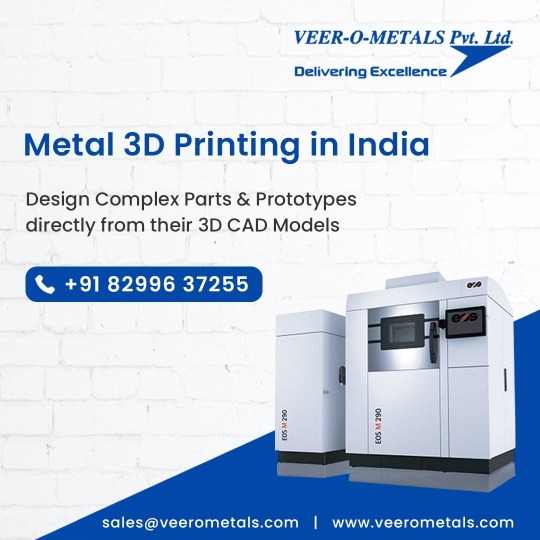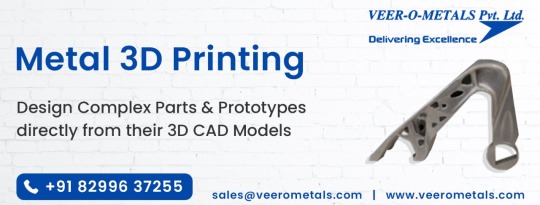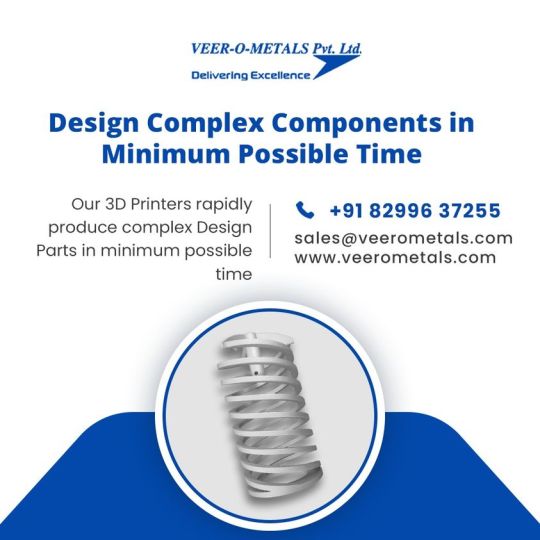#veerometals
Explore tagged Tumblr posts
Text

#metaladditivemanufecturing#metal3dprintingtechnology#meta3dprinting#metal3dprintingmaterials#Additive Manufacturing Solutions And Services | Metal 3D Printing in Bangalore Get a quote Today. For further information#kindly contact 9739991967 | 80-23712195 visit us : https://veerometals.com/ Mail us : [email protected]#veerometals#additivemanufacturing#metal3dprinting#3dprinting#sales#bangalore
0 notes
Photo

Veer-O-Metals Pvt. Ltd redefining the future of Manufacturing with the latest Additive Manufacturing Technology. Since 1965 the pioneer of Metal Additive Manufacturing & Metal 3D Printing in India. Metal additive manufacturing is the process of joining or solidifying metal pieces from a Veerometal.
0 notes
Text
Understanding of 3D Metals Printing
Additive manufacturing, or 3D metal printing, is a process that uses metal to build three-dimensional things layer by layer. The process depends on sending a digital data file to a machine that manufactures the component after receiving it. Complex items are produced using metal additive manufacturing without the limitations of conventional manufacturing techniques.
Metal components could not have been produced with 3D printing a few years ago. They may now be produced to strict standards utilizing a variety of metal powders. The fabrication of components for the most demanding purposes now makes use of it.
Metal part manufacture is a wasteful process in traditional processes. When making metal components for aircraft, up to 90% of the material is removed. Less energy is used and there is very little waste when using the 3D method. Up to 60% less weight can be added to finished 3D printed objects compared to their machined counterparts.
In the next few years, Veer-O-Metals, a significant player and one of the leading sheet metal stamping companies in India in the direct-metal printing market, expects that its metals business to reach a massive growth in the market. They have a strong technical team to handle all nature of work in the metal manufacturing segments.
For metal 3D printing, a number of metal materials are available. Stainless steel, aluminum, nickel, cobalt-chrome, and titanium alloys are the most often utilized materials. Tool steels, nickel-based alloys, precious metal alloys, and copper alloys are further materials. Tensile strength, hardness, and elongation characteristics are crucial when choosing a material. The proper material for a project can be easily taken into account in a product's specification due to the broad variety of materials available.
No filaments are used in 3D metal printing. The foundation is actually a very fine steel powder. Since 3D printers will be producing extremely thin printing layers, any form of powder cannot be used. To hold an even surface, the powder needs to be correctly formed. A roller is used to spread a very thin layer of steel powder. The design-related portions of the layer are then covered with tiny drips of glue by a printer head. Next, the layer is dried with the use of strong overhead heaters. The printer head will systematically adhere the right areas of each layer together while the 3D printer continues to spread out one layer of powder after another.
The most active sector of the economy has been the automotive sector, which has made investments in additive manufacturing for both mass-produced and prototype products. Automakers are refining their prototypes and beginning to mass produce more of their components and specialized equipment.
The metal 3D process has a number of benefits. Complex, customized pieces that are impossible to fabricate using traditional manufacturing techniques can be created using metal printing procedures. The application of metal 3D Machined components can be maximized while minimizing their weight and the overall number of components in a fabrication.
Superior physical qualities can be found in metal 3D printed items. Materials that are challenging to process, such metal superalloys, are among the range of materials that are available. If a design needs to be modified, the process is simple and simply necessitates the pressing of a few buttons, as opposed to an expensive and time-consuming re-design. Because the design is created as a single continuous piece rather than using several welds, the finished goods are sturdy and strong.
#veerometals#additivemanufacturing#metal3dprinting#3dprinting#aeroindustry#aerospace#healthcare#construction#industry#supplychain#help#quality#sales#business#metaladditivemanufecturing#metal3dprintingtechnology#meta3dprinting#metal3dprintingmaterials
0 notes
Text

#veerometals#additivemanufacturing#metal3dprinting#3dprinting#aeroindustry#aerospace#healthcare#construction#industry#supplychain#help#quality#sales#business#metaladditivemanufecturing#metal3dprintingtechnology#meta3dprinting#metal3dprintingmaterials
0 notes
Text
BENEFITS OF 3D PRINTING TECHNOLOGY
SPEED
Rapid prototyping is one of the main benefits of 3D printing technology. The capacity to design, produce, and test a customised part quickly is known as rapid prototyping. Additionally, if necessary, the design can be changed without impairing how quickly something is made. Before the 3D printing business took off, it would take weeks to produce a prototype. The procedure took an additional few weeks each time a change was made. When shipping schedules are taken into account, the entire product development process might easily take a year. Using 3D printing methods, a company may design a product, produce it internally on a 3D printer, and test it all in a matter of days.
COST
The most economical manufacturing method is 3D printing for small production runs and applications. A lot of expensive machines are needed for traditional prototyping techniques like CNC machining and injection moulding, and their higher labour costs are a result of the need for skilled operators and technicians to operate the machines.
This is in contrast to the 3D printing process, where (depending on the system) just 1 or 2 machines and fewer operators are required to make a part. Because the part is constructed from the ground up rather than being cut out of a solid block as in subtractive manufacturing, there is far less waste material and it typically does not require additional tooling.
SUITABILITY
A significant benefit of 3D printing is that any printer can produce practically anything as long as it fits inside its build volume. With conventional manufacturing techniques, each new part or modification to an existing part design necessitates the production of a new tool, mould, die, or jig.
In 3D printing, the design is input into slicer software, any supports that are required are added, and the print is then completed with little to no changes to the actual hardware or tools. Geometries that are hard for traditional technologies to construct, either as a single part or at all, can be designed and manufactured using 3D printing. Geometries of this type contain pieces inside other parts and hollow voids inside solid objects.
CONCURRENT ADVANTAGE
Product life cycles are shortened by 3D printing's speed and cheaper prices. Businesses have the ability to develop and improve a product, enabling them to provide better products in less time. By enabling a physical demonstration of a new product to customers and investors rather than relying solely on their imaginations, 3D printing lowers the likelihood that information will be lost or misconstrued during communication.
Additionally, it enables risk-free market testing at a minimal cost, collecting input from prospective buyers and investors on a physical product without having to incur significant up-front costs for prototyping.
Product Durability
Traditional production techniques might lead to subpar designs and subpar prototypes. Imagine making a cake, where the various components are joined, mixed, and then baked in the oven. If this were to occur, the cake would have issues like air bubbles or might not bake all the way through. With subtractive or injection processes, the same thing can happen; quality is not always guaranteed.
Due to the nature of 3D printing, it is possible to assemble a component or product piece by piece, which ensures that the design will be improved and the part or product will be of higher quality.
PRODUCT TESTING AND TANGIBLE DESIGN
As was previously said under competitive advantages, holding and feeling a prototype in person is incomparable to viewing a product on a screen. Testing a physical prototype allows for the discovery of any problems, which can then be corrected in the CAD file and a fresh copy printed the following day.
ECO-FRIENDLY
Fewer parts require outsourced for metal stamping manufacturers thanks to 3D printing. As a result, there is a decrease in the amount of shipping that occurs around the world and there is no longer a requirement to run and maintain an energy-intensive manufacturing.
For a single product, 3D printing generates a lot less waste, and the materials are frequently recyclable. The key benefits of 3D printing may be seen in its benefits in terms of speed, flexibility, and cost. The usage of 3D printing is far preferable than conventional industrial processes for short production runs, prototyping, small businesses, and educational purposes.
0 notes
Text

0 notes
Photo

Additive Manufacturing Solutions And Services | Metal 3D Printing in Bangalore.
Get a quote Today. For further information, kindly contact 9739991967 | 80-23712195
Visit us : https://veerometals.com/
Mail us : [email protected]
0 notes
Photo

We are specialized in manufacturing customized products for various business sectors with our transparent and global practices that has led us to be a technology leader in manufacturing of sheet metal fabrication parts and mechanical assemblies. Visit http://www.veerometals.com/ or Call +91 9513422844 to know more about us.
0 notes